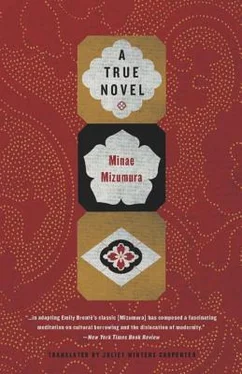Minae Mizumura - A True Novel
Здесь есть возможность читать онлайн «Minae Mizumura - A True Novel» весь текст электронной книги совершенно бесплатно (целиком полную версию без сокращений). В некоторых случаях можно слушать аудио, скачать через торрент в формате fb2 и присутствует краткое содержание. Год выпуска: 2013, Издательство: Other Press, Жанр: Современная проза, на английском языке. Описание произведения, (предисловие) а так же отзывы посетителей доступны на портале библиотеки ЛибКат.
- Название:A True Novel
- Автор:
- Издательство:Other Press
- Жанр:
- Год:2013
- ISBN:нет данных
- Рейтинг книги:4 / 5. Голосов: 1
-
Избранное:Добавить в избранное
- Отзывы:
-
Ваша оценка:
- 80
- 1
- 2
- 3
- 4
- 5
A True Novel: краткое содержание, описание и аннотация
Предлагаем к чтению аннотацию, описание, краткое содержание или предисловие (зависит от того, что написал сам автор книги «A True Novel»). Если вы не нашли необходимую информацию о книге — напишите в комментариях, мы постараемся отыскать её.
A True Novel
The winner of Japan’s prestigious Yomiuri Literature Prize, Mizumura has written a beautiful novel, with love at its core, that reveals, above all, the power of storytelling.
A True Novel — читать онлайн бесплатно полную книгу (весь текст) целиком
Ниже представлен текст книги, разбитый по страницам. Система сохранения места последней прочитанной страницы, позволяет с удобством читать онлайн бесплатно книгу «A True Novel», без необходимости каждый раз заново искать на чём Вы остановились. Поставьте закладку, и сможете в любой момент перейти на страницу, на которой закончили чтение.
Интервал:
Закладка:
Maybe that idealism was still in the air; maybe that was what I found so refreshing when I first stood in front of Seijo station.
The Shigemitsus had once lived near the Andos in central Tokyo. In the late 1920s, when the Odakyu Line opened, their children, Noriyuki and Yayoi, began commuting to Seijo Academy’s elementary school, in the care of a live-in student or one of the maids. In 1930 the family moved to the Seijo area and, soon, into a new Victorian-style house. Only a couple of years later, however, the entire family, along with the Demon, moved to London, where Mr. Shigemitsu was transferred by his company. They ended up renting out their scarcely lived-in house to a retired politician and his wife.
Not long after they left for London, the Saegusas arrived in Seijo. Given the delicate constitution of the youngest daughter, Fuyue, their doctor had advised them to move to a neighborhood where she could breathe good country air, and they decided on Seijo, where all three daughters could go to the school there. After renting for a while, they bought a piece of land that happened to be next to the Shigemitsus.
That coincidence was the beginning of all that followed.
I can well imagine how seeing the Shigemitsus’ mansion on its large plot next door must have affected the Saegusa girls. With the family far away in London, the girls could only fantasize about these glamorous neighbors of theirs. What was life like for them in a foreign country? What were the children like? When they came back from England, would they become friends? The girls spent one year, then another, and a whole year more, thinking about them, until one day the Shigemitsu family at last materialized. It was 1937. By coincidence, that was the year I was born.
To see a girl about their own age dressed so fashionably must have impressed the Saegusa girls no end. The way her parents looked must also have struck them as astonishingly modern and à la mode—all the more so because of the singular depth of their aspirations, in ways both good and bad. On sunny afternoons, the girls used to peer through the hedge and watch their neighbors taking tea on the porch while an impressive number of maids fussed around them. In the evenings they would hear the family playing classical music in the parlor. The Shigemitsus’ stay in London had only enhanced their already considerable social standing, so the girls got to see the more prominent residents of Seijo, including some quite well-known writers and artists, come and go.
How the sisters, especially the strong-willed Harue, must have longed to become friends with their newly returned neighbor! How delighted she must have been that Yayoi happened to be placed in the same class in school! How proud—and surprised—she must have felt when she realized that Yayoi went out of her way to seek their company! I could just imagine it all.
Yayoi, for her part, was lonely when she first got back to Japan. Not long after her family had left for London, there was some trouble at Seijo Academy, which meant that she returned to find many of the teachers and students she’d known were gone. For a girl who was shy in the way that people who form intense bonds often are, making friends was no easy matter. But then living right next door to her were these three sisters, about her age, whose looks and talents everyone at school admired; what’s more, the sisters were more than ready to help her readjust to life in Japan. To Yayoi the three girls seemed heaven-sent, and she quite lost her heart to them.
Eventually the two families grew close enough for Mr. Saegusa to buy half of the Shigemitsus’ lot in Karuizawa. The friendship with their neighbors must have given the Saegusas confidence. At a time when the majority of people were falling in with the increasingly militaristic and anti-Western government rhetoric, they flaunted their Western lifestyle. They built a Western-style villa, next to and almost identical to the one built by the Shigemitsus. Though the house was a fairly simple country place, nothing extravagant, it still wasn’t easy to get it built with the war industry gearing up, depleting supplies, and with more and more restrictions being placed on new construction; they had no recourse but to sell some of their holdings to cover the cost and at times even make under-the-table payments.
With Karuizawa a second source of contact, the two families’ ties only grew stronger. And then there was Yayoi’s elder brother, Noriyuki. His presence even further attracted the three sisters and gave an almost predestined aspect to the family connection. Noriyuki returned from England ahead of the others to go to a preparatory school for the Imperial University, where he focused on the natural sciences. He had to live in a dormitory there, so, even after his family moved back, he hardly ever came home to Seijo. In Karuizawa, though, he was right next door to the girls for the whole summer.
Militarism might permeate Tokyo life, but Karuizawa still maintained some of its freedom and openness. The Saegusa family always liked what was gay and flamboyant. With Noriyuki nearby, the girls came into bloom, and the circle of friends and admirers around them grew steadily, as though attracted by the scent of flowers. They were a lively group, welcoming a wide variety of people. The fact that Noriyuki played the clarinet and performed with other musicians from various countries was another asset, adding music and a cosmopolitan air to the charm of the place.
This group got together in Karuizawa summer after summer, and it revolved around the three sisters. The elder two developed from young girls into young women. It was probably the happiest time in their lives.
After graduating from Seijo Academy, Yayoi went to the Sacred Heart language school in central Tokyo. Harue and Natsue, saying they were fed up sitting in classrooms with the hoi polloi, hoped their father would send them to France to study dressmaking. They started learning the basics with Yayoi’s mother, who, from what I gathered, had been taught in London alongside other would-be seamstresses. They also commuted once a week to a French lady’s house to learn the language. The two of them even got lessons in European cooking from the Demon. In other words, they were trained for possible future careers while getting the grooming to become perfect Westernized wives. Meanwhile Fuyue devoted herself to practicing the piano.
So that was their life when, overnight, Japan went to war against the United States. After two or three years of that war, and daily casualty lists, the freedom that had been so much a part of life in Karuizawa drained away. The families tried their best to ward off this reality and wait out the war, but then every illusion of normal life that they’d been able to hold on to came crashing down.
Late in 1943, Noriyuki got his draft notice in the feared but familiar form of a red postcard. His family was still trying to adjust to this new situation when, early the following year, they received notice of his death. He died not as an officer in training but as a common soldier. Apparently, he had wanted to be a physicist and go to Cambridge after the war. Harue was twenty-two at the time, Natsue twenty-one, and Fuyue eighteen.
“THEY WERE ALL so conceited!” the Demon told us. According to her, each of the three girls was convinced she would be Noriyuki’s bride. In that wartime period, men married less selectively than in ordinary times, knowing they would soon go off to fight—often only because a wife would be able to look after their aging parents if they never returned. Why Noriyuki hadn’t married anyone before he left for the front remained an unanswered question in the sisters’ minds. And because it remained unanswered, it has haunted them to this day.
Noriyuki’s death also spelled the end of their youth and innocence.
Читать дальшеИнтервал:
Закладка:
Похожие книги на «A True Novel»
Представляем Вашему вниманию похожие книги на «A True Novel» списком для выбора. Мы отобрали схожую по названию и смыслу литературу в надежде предоставить читателям больше вариантов отыскать новые, интересные, ещё непрочитанные произведения.
Обсуждение, отзывы о книге «A True Novel» и просто собственные мнения читателей. Оставьте ваши комментарии, напишите, что Вы думаете о произведении, его смысле или главных героях. Укажите что конкретно понравилось, а что нет, и почему Вы так считаете.












